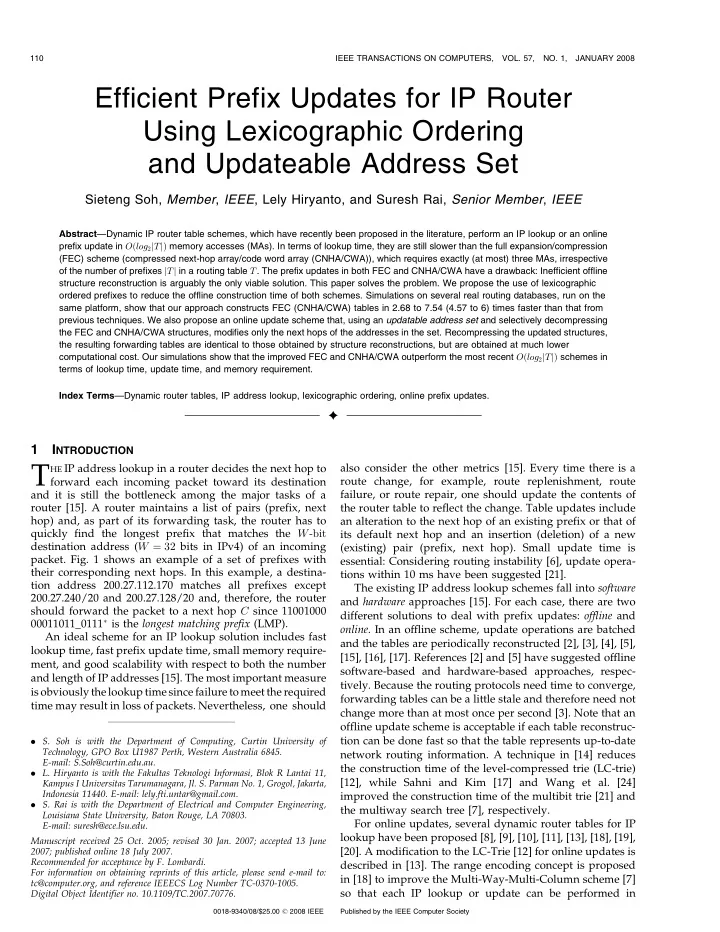

110 IEEE TRANSACTIONS ON COMPUTERS, VOL. 57, NO. 1, JANUARY 2008 Efficient Prefix Updates for IP Router Using Lexicographic Ordering and Updateable Address Set Sieteng Soh, Member , IEEE , Lely Hiryanto, and Suresh Rai, Senior Member , IEEE Abstract —Dynamic IP router table schemes, which have recently been proposed in the literature, perform an IP lookup or an online prefix update in O ð log 2 j T jÞ memory accesses (MAs). In terms of lookup time, they are still slower than the full expansion/compression (FEC) scheme (compressed next-hop array/code word array (CNHA/CWA)), which requires exactly (at most) three MAs, irrespective of the number of prefixes j T j in a routing table T . The prefix updates in both FEC and CNHA/CWA have a drawback: Inefficient offline structure reconstruction is arguably the only viable solution. This paper solves the problem. We propose the use of lexicographic ordered prefixes to reduce the offline construction time of both schemes. Simulations on several real routing databases, run on the same platform, show that our approach constructs FEC (CNHA/CWA) tables in 2.68 to 7.54 (4.57 to 6) times faster than that from previous techniques. We also propose an online update scheme that, using an updatable address set and selectively decompressing the FEC and CNHA/CWA structures, modifies only the next hops of the addresses in the set. Recompressing the updated structures, the resulting forwarding tables are identical to those obtained by structure reconstructions, but are obtained at much lower computational cost. Our simulations show that the improved FEC and CNHA/CWA outperform the most recent O ð log 2 j T jÞ schemes in terms of lookup time, update time, and memory requirement. Index Terms —Dynamic router tables, IP address lookup, lexicographic ordering, online prefix updates. Ç 1 I NTRODUCTION T also consider the other metrics [15]. Every time there is a HE IP address lookup in a router decides the next hop to forward each incoming packet toward its destination route change, for example, route replenishment, route and it is still the bottleneck among the major tasks of a failure, or route repair, one should update the contents of router [15]. A router maintains a list of pairs (prefix, next the router table to reflect the change. Table updates include hop) and, as part of its forwarding task, the router has to an alteration to the next hop of an existing prefix or that of quickly find the longest prefix that matches the W -bit its default next hop and an insertion (deletion) of a new destination address ( W ¼ 32 bits in IPv4) of an incoming (existing) pair (prefix, next hop). Small update time is packet. Fig. 1 shows an example of a set of prefixes with essential: Considering routing instability [6], update opera- their corresponding next hops. In this example, a destina- tions within 10 ms have been suggested [21]. tion address 200.27.112.170 matches all prefixes except The existing IP address lookup schemes fall into software 200.27.240/20 and 200.27.128/20 and, therefore, the router and hardware approaches [15]. For each case, there are two should forward the packet to a next hop C since 11001000 different solutions to deal with prefix updates: offline and 00011011_0111 � is the longest matching prefix (LMP). online . In an offline scheme, update operations are batched An ideal scheme for an IP lookup solution includes fast and the tables are periodically reconstructed [2], [3], [4], [5], lookup time, fast prefix update time, small memory require- [15], [16], [17]. References [2] and [5] have suggested offline ment, and good scalability with respect to both the number software-based and hardware-based approaches, respec- and length of IP addresses [15]. The most important measure tively. Because the routing protocols need time to converge, is obviously the lookup time since failure to meet the required forwarding tables can be a little stale and therefore need not time may result in loss of packets. Nevertheless, one should change more than at most once per second [3]. Note that an offline update scheme is acceptable if each table reconstruc- tion can be done fast so that the table represents up-to-date . S. Soh is with the Department of Computing, Curtin University of Technology, GPO Box U1987 Perth, Western Australia 6845. network routing information. A technique in [14] reduces E-mail: S.Soh@curtin.edu.au. the construction time of the level-compressed trie (LC-trie) . L. Hiryanto is with the Fakultas Teknologi Informasi, Blok R Lantai 11, [12], while Sahni and Kim [17] and Wang et al. [24] Kampus I Universitas Tarumanagara, Jl. S. Parman No. 1, Grogol, Jakarta, Indonesia 11440. E-mail: lely.fti.untar@gmail.com. improved the construction time of the multibit trie [21] and . S. Rai is with the Department of Electrical and Computer Engineering, the multiway search tree [7], respectively. Louisiana State University, Baton Rouge, LA 70803. For online updates, several dynamic router tables for IP E-mail: suresh@ece.lsu.edu. lookup have been proposed [8], [9], [10], [11], [13], [18], [19], Manuscript received 25 Oct. 2005; revised 30 Jan. 2007; accepted 13 June [20]. A modification to the LC-Trie [12] for online updates is 2007; published online 18 July 2007. Recommended for acceptance by F. Lombardi. described in [13]. The range encoding concept is proposed For information on obtaining reprints of this article, please send e-mail to: in [18] to improve the Multi-Way-Multi-Column scheme [7] tc@computer.org, and reference IEEECS Log Number TC-0370-1005. so that each IP lookup or update can be performed in Digital Object Identifier no. 10.1109/TC.2007.70776. 0018-9340/08/$25.00 � 2008 IEEE Published by the IEEE Computer Society
Recommend
More recommend